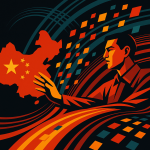Key Points
- Multiple Chinese government departments, including the Kējì Bù (科技部), PBOC (中国人民银行), and CSRC (中国证券监督管理委员会), are aligning policies to accelerate tech finance and support innovation, including measures to support the listing of high-quality unprofitable sci-tech enterprises.
- The CSRC (中国证券监督管理委员会) is focusing on deepening reforms for the STAR Market and ChiNext to better serve sci-tech innovation, actively promoting the fifth set of listing standards on the STAR Market (科创板) to enable unprofitable “hard tech” companies to go public.
- Xiaomi (小米) celebrated its 15th anniversary, launching new products featuring its self-developed Xuanjie (玄戒) chip (including the Xiaomi 15S Pro and Xiaomi Pad 7 Ultra) and teasing its upcoming Xiaomi YU7 SUV, with rumors suggesting the previously rumored ¥199,000 price is “impossible.”
- Significant market activity includes Hongchuang Holdings’ (宏创控股) planned ¥63.518 billion (approx. $8.82 billion USD) acquisition and CATL’s (宁德时代) strong Hong Kong debut, indicating strong international capital interest in high-quality Chinese assets.
- China’s consumer market shows growth, with a boom in two-wheeler sales driven by subsidies and the emergence of a ¥400 billion RMB (approx. $55.6 billion USD) “camping economy.”

Get the inside scoop on China’s electrifying tech and finance scene for May 23, 2025, as big policies and market moves unfold, offering a crucial snapshot for investors, founders, and tech enthusiasts.
Let’s dive into the top stories shaping the landscape.
Big Policy Push: Fueling China’s Tech Ambitions 🚀
It’s clear: boosting tech and innovation is high on the agenda.
Multiple government departments are stepping up to the plate.
Heavy Hitters Align on Tech Finance Policies
Top officials from key institutions gathered on May 22nd to talk tech finance strategy.
We’re talking about:
- Qiu Yong, Vice Minister of Science and Technology (Kējì Bù 科技部)
- Zhu Hexin, Deputy Governor of the People’s Bank of China (PBOC) (Zhōngguó Rénmín Yínháng 中国人民银行) and Administrator of the State Administration of Foreign Exchange (SAFE) (Guójiā Wàihuì Jú 国家外汇局)
- Guo Wuping, spokesperson for the National Administration of Financial Regulation (NAFR) (Jīnróng Jiānguǎn Zǒngjú 金融 Jiānguǎn Zǒngjú)
- Yan Bojin, Chief Risk Officer of the China Securities Regulatory Commission (CSRC) (Zhōngguó Zhèngjiān Huì 中国证券监督管理委员会)
Their focus? Laying out the latest on technology finance policies designed to supercharge innovation.
Accelerating a Multi-Level Tech and Finance Service System
Speaking of policies, seven departments recently dropped the “Several Policy Measures to Accelerate the Construction of a Technology Finance System to Strongly Support High-Level Sci-Tech Self-Reliance and Self-Improvement.”
That’s a mouthful, but the gist is clear: a concerted effort to build a robust support system for tech.
The PBOC specifically mentioned plans to enhance the strength and capability of technology loan disbursement.
More cash for tech, basically.
The Ministry of Science and Technology (Kējì Bù 科技部) and the “One Bank, One Administration, One Commission” (referring to PBOC, NAFR, CSRC) are doubling down on implementation.
They’re looking to:
- Optimize the technology finance development environment.
- Support the listing of high-quality unprofitable sci-tech enterprises – a potential game-changer for “hard tech” startups.
Expect an upgraded version 2.0 of the “Innovation Credit System” and more robust tech insurance services.
The detail? Task divisions are being refined, and implementation timelines are being clarified. Things are moving fast.

Find Top Talent on China's Leading Networks
- Post Across China's Job Sites from $299 / role
- Qualified Applicant Bundles
- One Central Candidate Hub
Your First Job Post Use Checkout Code 'Fresh20'

CSRC Corner: Making Markets Work for Tech 📈
The CSRC (Zhōngguó Zhèngjiān Huì 中国证券监督管理委员会) is taking a lead role in making China’s capital markets more tech-friendly.
Deepening Reforms for STAR Market and ChiNext
Yan Bojin from the CSRC highlighted a focus on serving sci-tech innovation and the development of New Quality Productive Forces (Xīn Zhì Shēngchǎnlì 新质生产力).
Key areas of action include:
- Continuously optimizing the environment for domestic listing of sci-tech enterprises.
- Better coordinating and leveraging the functions of various boards to support sci-tech enterprises.
- Accurately supporting the listing of “hard tech” enterprises.
- Increasing efforts to support the industrial integration of sci-tech enterprises.
- Cultivating and strengthening long-term capital and patient capital.
- Better utilizing the bond market to support sci-tech innovation.
The CSRC plans to work with other departments to get these measures implemented ASAP.
Spotlight on STAR Market’s Fifth Set of Listing Standards
A big question on everyone’s mind: Can unprofitable tech companies list?
The CSRC is strongly promoting the implementation of the fifth set of listing standards on the STAR Market (Kēchuàng Bǎn 科创板).
This is huge because it opens the door for unprofitable enterprises with high “hard tech” content and excellent overall quality to go public.
They’re also looking to support the return of high-quality Red Chip sci-tech enterprises for domestic listing.

ExpatInvest China
Grow Your RMB in China:
- Invest Your RMB Locally
- Buy & Sell Online in CN¥
- No Lock-In Periods
- English Service & Data
- Start with Only ¥1,000

Xiaomi’s Big Day: New Chips, Gadgets, and an SUV Tease 📱🚗
Xiaomi (Xiǎomǐ 小米) just celebrated its 15th anniversary with a bang, dropping some serious new tech.
The “Xuanjie” Chip Era Begins
The star of the show? Xiaomi’s self-developed Xuanjie (Xuán Jiè 玄戒) chip.
This new silicon is powering:
- The Xiaomi 15S Pro high-end smartphone.
- The Xiaomi Pad 7 Ultra.
- The Xiaomi Watch S4.
Zaker Li, Chief Analyst at Omdia, noted that the first-gen “Xuanjie O1” is primarily for technical verification, with conservative shipment plans in the hundreds of thousands.
Expect high initial costs due to small-scale tape-out, but this is a big step for Xiaomi’s ecosystem ambitions.
The competition in mobile chips and terminal ecosystems is definitely heating up!
SUV Buzz: Xiaomi YU7 – Price Point “Impossible”?
Beyond personal tech, Xiaomi also unveiled large home appliance products.
But the real teaser? Key info about its first SUV model, the Xiaomi YU7.
Interestingly, there’s a buzz that a previously rumored price of ¥199,000 RMB (approx. $27,638 USD) is “impossible” for the YU7, suggesting a different pricing strategy might be in play.
Stay tuned for that one!

Resume Captain
Your AI Career Toolkit:
- AI Resume Optimization
- Custom Cover Letters
- LinkedIn Profile Boost
- Interview Question Prep
- Salary Negotiation Agent

Market Movers & Shakers: Acquisitions and Star Performers 💰
The markets are always active, and today is no exception.
Hongchuang Holdings Lines Up Massive ¥63.5 Billion Acquisition
Hongchuang Holdings (Hóngchuàng Kònggǔ 宏创控股) (002379) is making waves with a planned major asset restructuring.
They intend to issue shares to acquire 100% equity of Shandong Hongtuo Industry Co., Ltd. (Shāndōng Hóngtuò Shíyè Yǒuxiàn Gōngsī 山东宏拓实业有限公司).
The sellers include Shandong Weiqiao Aluminum & Electricity Co., Ltd. (Shāndōng Wèiqiáo Lǚdiàn Yǒuxiàn Gōngsī 山东魏桥铝电有限公司).
The transaction value? A hefty ¥63.518 billion RMB (approx. $8.82 billion USD).
Importantly, this is a major asset restructuring but not a backdoor listing, and the company’s controlling shareholder will remain unchanged.
CATL’s Hong Kong Triumph: International Capital Loves Chinese Assets
Battery giant CATL (Níngdé Shídài 宁德时代) (300750) had a stellar debut on the Hong Kong stock market.
It closed up 16.43% on May 20th, surpassing its A-share price, and then jumped another 10% the next day.
This suggests that high-quality Chinese companies are getting a premium in the Hong Kong market, likely due to its deeper liquidity.
A clear sign that global capital is still keen on “embracing” top-tier Chinese assets.

Capital Flows & Monetary Pulse: Keeping the Economy Liquid 💧
The PBOC is actively managing liquidity, and new investment vehicles are emerging.
PBOC’s ¥500 Billion MLF Injection
To keep the banking system flush with cash, the People’s Bank of China (PBOC) (Zhōngguó Rénmín Yínháng 中国人民银行) conducted a ¥500 billion RMB (approx. $69.44 billion USD) Medium-term Lending Facility (MLF) (zhōngqī jièdài biànlì 中期借贷便利) operation on May 23rd.
This one-year tenor operation used fixed quantities, interest rate bidding, and multi-price allocation methods.
The PBOC noted that its improved MLF bidding mechanism (announcing tenders in advance) helps banks manage liquidity better.
Plus, multi-price allocation helps the PBOC gauge institutional liquidity needs while improving banks’ market-based pricing skills.
Interestingly, as channels for injecting base money expand, reliance on MLF operations might be gradually decreasing.
Honghu Fund Phase II & Insurance Capital: The Rise of “Patient Capital”
The upcoming launch of Honghu Fund Phase II is seen as a positive move.
Industry insiders believe such funds, focusing on long-term holdings in secondary market stocks, are key to expanding “patient capital” in the market.
This helps improve the capital market’s fund supply structure.
For insurance companies, this strategy can smooth out the impact of equity market volatility on profits and ease pressure from declining interest margins in a low-interest-rate world.
China’s Outbound Investment on the Rise
From January to April 2025, China’s total outbound direct investment (ODI) hit $57.54 billion USD, up 7.5% year-on-year.
Non-financial ODI reached $51.04 billion USD, a 5.6% increase.
Investment in countries part of the “Belt and Road Initiative” (Yīdài Yīlù 一带一路) was particularly strong, reaching $12.78 billion USD, a jump of 16.4%.
This data comes straight from He Yongqian, spokesperson for the Ministry of Commerce (MOFCOM) (Shāngwù Bù 商务部).

Consumer Beat: Spending Trends Driving Growth 🛍️🚲🏕️
China’s consumer market is showing exciting trends.
National Subsidies Spark Two-Wheeler Sales Boom
A visit to two-wheeler brand stores in Beijing reveals a significant uptick in customer traffic.
Thanks to a national subsidy policy, many consumers are trading in old vehicles for new ones, receiving subsidies of ¥500 to ¥650 RMB (approx. $70 to $90 USD).
Combine that with the old vehicle’s residual value, and a two-wheeler priced around ¥2,000 RMB (approx. $280 USD) can be had for just over ¥1,000 RMB (approx. over $140 USD).
The result? Hot sales and stock shortages for some models. The two-wheeler industry is definitely in the fast lane.
Camping Economy: A ¥400 Billion RMB Blue Ocean
Picnics, bonfires, and quality time outdoors – camping is more than just a pastime; it’s a booming economic trend.
This “camping economy” is catalyzing a market estimated to be worth a staggering ¥400 billion RMB (approx. $55.6 billion USD).
People are embracing the tranquility and beauty of the outdoors, and businesses are taking note.
MOFCOM: Boosting Consumption for Stronger Domestic Circulation
The Ministry of Commerce (MOFCOM) (Shāngwù Bù 商务部) is focused on leveraging consumption to drive economic circulation and strengthen the “Domestic Circulation” (Guónèi Dà Xúnhuán 国内大循环) strategy.
Spokesperson He Yongqian stated MOFCOM will emphasize “acceleration,” strengthen “improvement,” and focus on “effectiveness.”
The goal is to expand high-level opening up (Gāoshuǐpíng Duìwài Kāifàng 高水平对外开放) and ensure high-quality development amidst global uncertainties.

Market Watch: Volatility, Land Deals, and Global Bond Jitters 🌍
Keeping an eye on market risks and opportunities is crucial.
High-Flying Stocks and Speculation Warnings
Fund speculation in some “high-flying” stocks is raising eyebrows, and bank stocks have rallied to stabilize the market at times.
Valuations for stocks that have doubled are looking pretty stretched.
Take Zhongyida (Zhōngyìdá 中毅达) (600610), for example.
The company itself warned that its A-share stock price soared 252.61% between March 10 and May 22, 2025, even though its fundamentals haven’t changed much.
It was loss-making in 2024, and its price-to-book ratio is way above the industry average.
This signals that the stock price is detached from fundamentals, driven by overly enthusiastic market sentiment and high speculation risk.
Revitalizing Land: Special Purpose Bonds in Action
A key task in the real estate sector this year is revitalizing existing land.
Localities are increasingly using local government special purpose bonds (Zhuānxiàng Zhài 专项债) to acquire idle existing land plots.
Nearly 3,000 plots are planned for acquisition using these bonds, totaling over 133 million square meters.
This is a significant move to address idle land and potentially support the property market.
Global Bond Market Tremors: Japan & US Auctions
There’s some nervousness around recent Japanese and US bond auctions receiving a “cold reception.”
The big question is who will pick up these “unwanted government bonds” and whether the risk will spill over.
Economists and traders suggest that while short-term panic is possible (similar to the UK Gilt crisis affecting pension funds), both the Bank of Japan and the US Federal Reserve likely have technical means to ease the situation.
The underlying concern remains: who are the buyers for this massive government debt?
Supporting SMEs: Balancing Policy with Market Dynamics
The National Administration of Financial Regulation (NAFR) (Jīnróng Jiānguǎn Zǒngjú 金融 Jiānguǎn Zǒngjú) and seven other ministries jointly issued “Several Measures to Support Financing for Small and Micro Enterprises.”
These include 23 measures across eight areas, like increasing financing supply and reducing comprehensive financing costs.
An editorial from Yicai (Dìyī Cáijīng 第一财经) highlights that while policy support for SME financing is crucial, it needs to be balanced with respecting market self-determination.
Precise departmental coordination and responsibility are key to making these measures effective.

Port Report: Peak Shipping Season on the Horizon 🚢
Changes in foreign trade and increased transport demand are leading to a rebound in freight rates on most long-haul routes since mid-to-late May.
Ports are expecting to hit a peak shipping period in late May or early June.
Amid global economic shifts, China’s shipping network is expanding and upgrading, especially towards emerging markets.
This is vital for unleashing foreign trade growth and ensuring economic resilience.
It’s a dynamic period for China’s tech and financial markets, with significant policy initiatives, exciting product developments, and evolving market conditions shaping the path forward in 2025.


![China Signals Major Investment Push: Vice Premier He Lifeng Meets ADIA Chairman, Eyeing Deeper Economic Ties & New China Investment Opportunities [FreshFromChina]](https://freshfromchina.com/wp-content/uploads/2025/05/china-signals-major-investment-push-vice-premier-he-lifeng-meets-adia-chairman.png____FreshFromChina-150x150.png)


